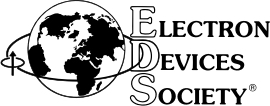Abstract EDS Webinar: Next-generation Electronics with 2D Materials - from atoms to applications
Next-generation Electronics with 2D Materials - from atoms to applications
Abstract:
Two-dimensional (2D) van der Waals materials such as graphene and various transition metal dichalcogenides (such as MoS2) possess a wide range of remarkable properties that make them attractive for a number of applications, including sub-5 nm VLSI (Physics Today, Sept. 2016). I will highlight the prospects of 2D materials for innovating energy-efficient transistors, sensors, interconnects, and passive devices targeted for next-generation electronics needed to support the emerging paradigm of the Internet of Things (IoT). More specifically, I will bring forward a few applications uniquely enabled by 2D materials and their heterostructures that have been demonstrated in my lab for realizing ultra-energy-efficient electronics. This includes the invention of the highest inductance-density materials ever made that helped overcome a 200-year old limitation of the Faraday-inductor and has opened up a new pathway for designing ultra-compact IoT systems (Nature Electronics 2018). Other innovations from my lab are the world’s thinnest channel (only two atomic layers of MoS2) band-to-band tunneling transistor that overcame a fundamental power consumption challenge in all electronic devices since the invention of the first transistor (Nature 2015), the first 2D-semiconductor channel based FET-biosensor with unprecedented sensitivity and promise of single-molecule detection (ACS Nano 2014), as well as a breakthrough interconnect technology based on doped-graphene-nanoribbons, which overcomes the fundamental limitations of conventional metals and provides an attractive pathway toward energy-efficient and highly reliable interconnects for next-generation integrated circuits (Nano Letters 2017). I will conclude with the prospects of monolithic 3D integration with 2D materials for realizing 3D ICs of ultimate thinness and integration density (IEEE S3S 2018).







